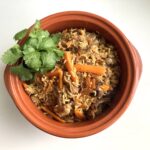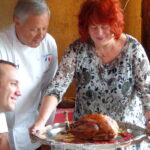 Plov is a rich and spicy rice dish from Central Asia that is traditionally made with lamb, although other meats are sometimes used. The lamb is browned with carrots and onions before being simmered with cumin seeds, paprika and turmeric or saffron. Quince or chickpeas may also be included. A layer of rice studded with whole cloves of garlic is added at the end and steamed to tender perfection to create a festive one-dish meal.
Plov is a rich and spicy rice dish from Central Asia that is traditionally made with lamb, although other meats are sometimes used. The lamb is browned with carrots and onions before being simmered with cumin seeds, paprika and turmeric or saffron. Quince or chickpeas may also be included. A layer of rice studded with whole cloves of garlic is added at the end and steamed to tender perfection to create a festive one-dish meal.
Plov d’agneau / Lamb and rice, Central Asian style
Although obviously not French, plov has made its way to Paris and beyond, brought by emigrés from Central Asian since the breakup of the former Soviet Union more than 30 years ago. Today’s recipe is based on the version served in Uzbekistan, where plov is the national dish — and in fact has been inscribed as such, under the name palov, on UNESCO’s ‘Representative List of the Intangible Cultural Heritage of Humanity’.
These names derive from the Persian pilav, which is of course also the root of the English-speaking world’s pilaf — although there is a world of difference between pilaf and plov. Not just the exotic spicing but also the incorporation of some fat into the dish make plov a far more regal experience than the pallid pilafs I was served as a child back in the States.
And speaking of names, a cut of lamb often used for plov is shoulder, but in the version shown in the photo above I used a French cut from beneath the shoulder that is amusingly named épigramme d’agneau. It’s an inexpensive cut with some fat attached and plenty of bones, which add delicious flavor to the plov. But how did it get its name, I wondered?
A quick web search turned up a plausible tale. Apparently a young noblewoman was serving dinner to some officers in the mid-18th century when one of them said they had dined at the home of a count who’d regaled them with excellent epigrams. The young woman, who didn’t know an epigram (‘clever saying’) from her elbow, turned to her cook, a creative chap named Michelet, and asked him to rustle some up for the next day’s dinner. At a loss as to what to do, the poor fellow cooked up some lamb — breast and ribs — and called it ‘épigrammes d’agneau a la Michelet‘. And so a name was born.
This is hardly the only French cut of meat with an amusing name. One of the best cuts of steak is called poire (‘pear’), apparently because of its shape. You will rarely see it displayed, however, as butchers hide it away for their best customers, along with two similar cuts, merlan (‘whiting’, as in the fish) and araignée (‘spider’).
For those of you who may be interested in such arcane bits of French culinary terminology, I promise to write about it again on another occasion. But right now I need to go make dinner — lamb soup (with the épigramme leftovers!). I hope you’ll try the plov.
Happy cooking.
 P.S. With Thanksgiving around the corner, here are some recipes that could lend a French touch to the festivities: Roast turkey, French style, Pumpkin gratin, Pumpkin soufflé, Penne with pumpkin and walnuts, Sweet potatoes with herbs and Walnut tart.
P.S. With Thanksgiving around the corner, here are some recipes that could lend a French touch to the festivities: Roast turkey, French style, Pumpkin gratin, Pumpkin soufflé, Penne with pumpkin and walnuts, Sweet potatoes with herbs and Walnut tart.




